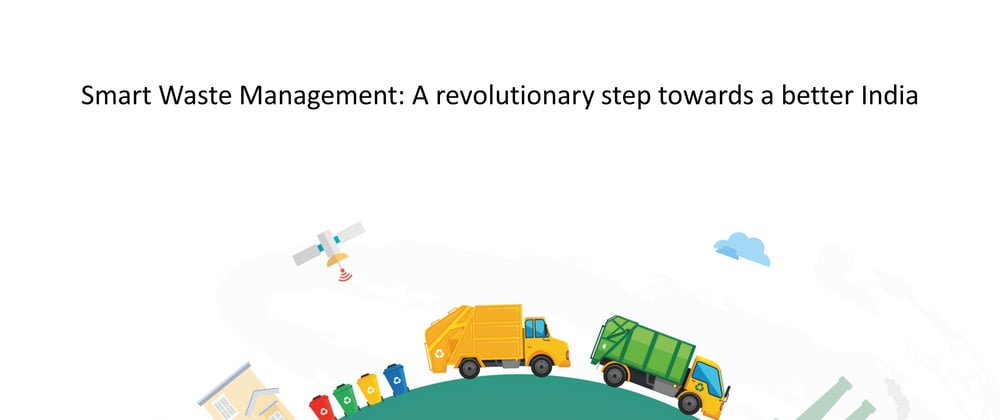Overview:
Of the many leading problems in India, WASTE MANAGEMENT stands at the forefront.
The existing system just dumps the entire garbage in a sanitary landfill. As a consequence, there emerged a shortage of land for composting waste. To make the situations even worse, the existing landfills are in a CRITICAL state.
Undoubtedly there emerges a requirement of the judicious method of waste handling, to cope up with the rising population and urbanization.
In this project, we intend to make the existing process SMARTER by employing computer vision to automatically sort the waste materials according to their category.
Description:
With a population of 133 billion people, India generates waste of 62 million tons annually. Out of this huge number, only 75 to 85% of the waste gets collected and only 22-28% of that amount is processed and treated. These figures are according to the Ministry of Environment, Forests and Climate Change.
The existing method of waste treatment includes mainly dumping the waste into sanitary landfills. The quite obvious reason behind this is that it is not practically viable to segregate those waste manually by hands. As a result, a huge amount of recyclable and other toxic or non-toxic wastes which has supposed to be treated in some other scientific manner ends up in the landfill. Data say that almost 80% of wastes in landfills of Delhi can be recycled.
Another small, yet significant portion of wastes remain uncollected and those pose a serious threat to city dwellers. If the hygiene and well-being of citizens are taken into consideration, those too need to be judiciously taken care of.
Our solution includes all-round management of wastes, beginning with proper collection to segregation and proper management according to their categories.
The current system of waste management can be classified and described as below:
• Waste collection
Household wastes are collected by municipal workers from home to home and from locality, wastes are collected from vats placed in several places across the city
The present method of collection mixes all types of waste, like plastic, organic, glass, ceramic, etc. and even liquid wastes
Though vats are supposed to be cleared at a regular interval, irregularities are a common sight. Resulting in overflowing of those and consequent spreading of hazardous gases and toxic materials besides the foul smell
• Waste handling
Since the wastes reach the processing plant all mingled together, there is no existing infrastructure to segregate them for proper management or handling
Proposed Solution:
• Waste collection
Smart dustbins will inform the municipal authority as and when they are filled up and needs to be cleared.
AI will predetermine when the dustbin will be filled up.
Google Maps API will be used to train a model to detect uncollected wastes, and also predetermine the type of wastes that may be generated from a particular region.
• Waste management
In a waste management plant, Computer Vision along with several sensors will be used to sort the wastes according to their category. This will ensure both proper recycling as well as efficient management of wastes.
Methodology / Approach
Architecture:
Proper waste management begins right from its collection. In that perspective we have divided our architecture into 3 parts:
• Introducing smart dustbin to ensure timely collection of wastes
• Using machine learning to adopt a no-waste-left-behind policy
• Segregation of wastes, using computer vision, according to its category for proper management.
Concept of SMART DUSTBIN
As mentioned above, vats or dustbins are not cleared timely, resulting in several problems. One possible reason behind this could be the lack of information regarding filling up of dustbins. To tackle this problem, we have come up with this concept of the smart dustbin.
As the name suggests, those dustbins will be connected to the internet to transmit the real-time data to the server regarding the space left until it gets filled up. The municipal corporation can keep a track of it and take actions as and whenever required.
Those data collected will also be used to train a machine learning model which will be able to predetermine the manual force required for waste collection from that particular region. This has got two advantages, firstly it will ensure judicious use of government force and at the same time yield better results.
No-Waste-Left-Behind
In this scheme, the same data set will be used to train Machine Learning models for two different purposes.
Data collected from Google maps API will be used to train a model to identify the places where a huge amount of wastes remain uncollected. Municipal authorities can dispatch the workforce accordingly for the collection of those wastes. In this way, we will be able to collect a huge part, if not full, of the 25% of the garbage that remains uncollected.
Again, this data will also give information about the category of wastes generated from that place. For example, fruits and vegetable market will mostly generate organic wastes. In this way, our job of processing the wastes will be easier, as sorting will be done from the source itself.
Waste management and segregation
The key to proper waste management lies in segregating it into different categories since they are to handled differently. We have classified waste into 3 parts:
(a) Recyclable waste
(i) Metals
(ii) Papers
(iii) Glass and Ceramics
(b) Organic waste
(c) Plastic waste
Computer Vision and Deep Learning will be used to differentiate between waste materials, based on their colour, size, texture and shape, etc. Further several sensors, like inductive proximity sensor, ultrasonic sensor, etc. will be integrated with it to aid in the process of segregation.
Interface:
A dashboard will be created to show all the necessary information about the dustbin according to its location; when it will be filled up and how much is filled. It will also show the types of wastes can be generated from a particular area. Municipal Authority will keep track of it and take the necessary steps to collect the waste.
Technologies Used
The following technologies will be used in this project:
Microsoft Azure will be used to gather and store the data collected, and will also take care of the post-processing.
Hardware & Sensors:
• Ultrasonic Proximity Sensor
• NodeMCU board
• 5V DC Power Supply
• Intel UP2 Board
• Intel RealSense Camera
• Inductive Proximity Sensor
Software:
• Microsoft Azure
• Python
• JavaScript
• Arduino
• Maps API
Project link: https://devmesh.intel.com/projects/smart-waste-management-a-revolutionary-step-towards-a-better-india
Link of Published paper: https://link.springer.com/chapter/10.1007/978-3-030-42363-6_79







Top comments (0)